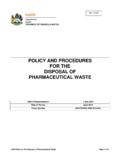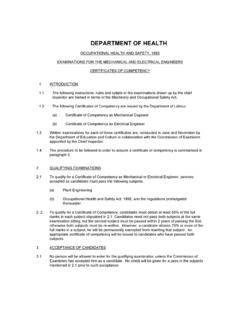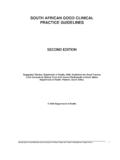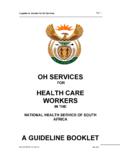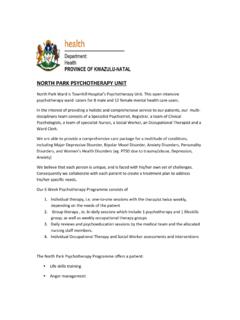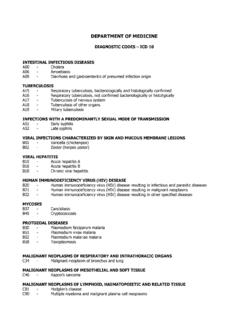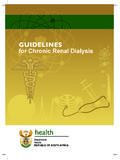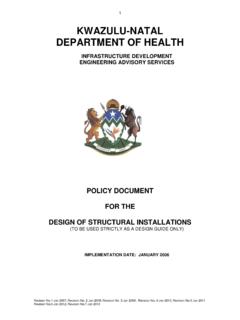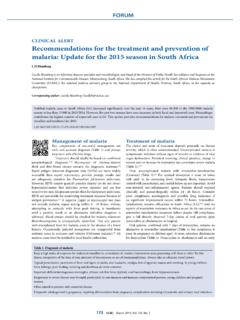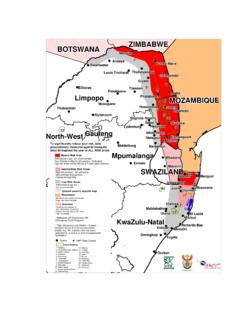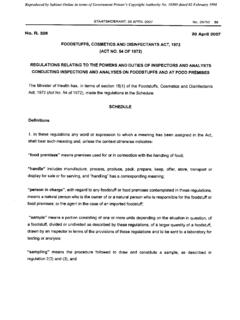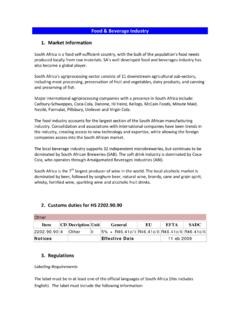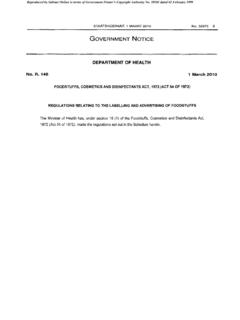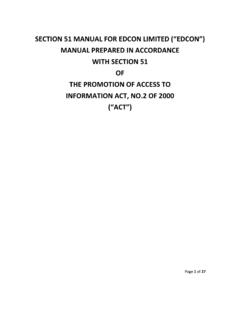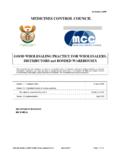Transcription of Municipal Health Services - Department of Health
1 Municipal Health Services TABLE OF CONTENTS PAGE/S: 1. INTRODUCTION 3 2. THE COMPONENTS OF Municipal Health Services (MHS): 3 WATER QUALITY MONITORING: 3 DEFINITION 3 FUNCTIONAL AREAS 3 FUNCTIONAL ACTIVITIES 4 FOOD CONTROL: 4 DEFINITION 4 FUNCTIONAL AREAS 4 FUNCTIONAL ACTIVITIES 5 WASTE MANAGEMENT: 6 DEFINITION 6 FUNCTIONAL AREAS 6 FUNCTIONAL ACTIVITIES 6 Health SURVEILLANCE OF PREMISES: 6 DEFINITION 6 FUNCTIONAL AREAS 7 FUNCTIONAL ACTIVITIES 8 SURVEILLANCE AND PREVENTION OF COMMUNICABLE DISEASES, EXCLUDING IMMUNISATIONS.
2 8 DEFINITION 8 FUNCTIONAL AREAS 8 FUNCTIONAL ACTIVITIES 8 VECTOR CONTROL: 9 DEFINITION 9 FUNCTIONAL AREAS 9 FUNCTIONAL ACTIVITIES 9 ENVIRONMENTAL POLLUTION CONTROL: 9 DEFINITION 9 FUNCTIONAL AREAS 9 FUNCTIONAL ACTIVITIES 10 NOISE POLLUTION CONTROL 10 AIR POLLUTION CONTROL 10 LAND AND SOIL POLLUTION CONTROL 10
3 WATER POLLUTION 10 DISPOSAL OF THE DEAD 10 DEFINITION 10 FUNCTIONAL AREAS 10 FUNCTIONAL ACTIVITIES 11 CHEMICAL SAFETY: 11 DEFINITION 11 FUNCTIONAL AREAS 11 FUNCTIONAL ACTIVITIES 11 3.
4 CONCLUSION 11 4. REFERENCES 11-12 1. INTRODUCTION: A joint ( Health and Local Government) MINMEC decision was taken in 2002 that Municipal Health Services (MHS) be defined as a list of Environmental Health Services (EHS). This decision was gazetted on 3 January and 13 June 2003 (latter gazette changed the date of implementation from July 2003 to July 2004 as agreed by the Ministers). According to the Municipal Structures Act, 1998 (Act No: 117 OF 1998), section 84(1)(i), Municipal Health Services (MHS) will the responsibility of District Municipalities (Category C) and not Local Municipalities (Category B). In addition, in terms of the National Health Act 2003, section 32(1), it is the exclusive competency of every Metropolitan (Category A) and District Municipalities (Category C) to ensure the provision/rendering of Municipal Health Services (MHS).
5 Category C Municipalities can also enter into a service level agreement with Local Municipalities (Category B) if they are not in a position to deliver Municipal Health Services (MHS). The Constitution of the Republic of South Africa, 1996 (Act No: 108 of 1996) allocates Municipal Health Services (MHS) as a Local Government function under Part B of Schedule 4, section 156(1)(a). On the other hand, the National Health Act, 2003, defines Municipal Health Services (MHS) as follows: (a) water quality monitoring (b) food control (c) waste management (d) Health surveillance of premises (e) surveillance and prevention of communicable diseases, excluding immunizations (f) vector control (g) environmental pollution control (h) disposal of the dead, and (i) chemical safety but excludes port Health , malaria control and control of hazardous substances 2. THE COMPONENTS OF Municipal Health Services (MHS): The various components of Municipal Health Services (MHS) will be divided into definitions, functional areas and functional activities as follows.
6 WATER QUALITY MONITORING: DEFINITION: Monitoring and surveillance of water quality and availability that is intended for human consumption, recreational and industrial use. FUNCTIONAL AREAS: Domestic water supply. Stormwater. Boreholes Wells Recreational water, public facilities such as swimming pools, water slides, spa-baths, whirlpools and wading pools. Lakes, dams, springs and watercourses. Rivers and streams not regulated by DWAF. FUNCTIONAL ACTIVITIES: Ensuring a hygienically safe and adequate supply of potable water provision. Respond to consumer complaints on contamination/impurities. Water sampling and testing for bacteriological and chemical analysis. Enforcement of laws and regulations related to water quality. Protection of water sources. Mapping of water sources in relation to pollution and contamination. Implement Health , hygiene and awareness and education campaigns.
7 Monitoring of water reticulation systems and other sources of water supply. Monitoring and control of stormwater runoff from premises, which may impact on public Health . Identification and making safe of dangerous wells, boreholes and excavations. FOOD CONTROL: DEFINITION: Food Control is described by the World Health Organization (WHO) as a mandatory regulatory activity of enforcement by National or Local authorities to provide consumer protection and ensure that all foods during production, handling, storage, processing and distribution are safe, wholesome and for human consumption; conform to quality and safety requirements and are honestly and accurately labeled as prescribed by law. FUNCTIONAL AREAS: FORMAL PREMISES: Food retailers (restaurants, cafes, franchises, fast-food outlets, bakeries, supermarkets, butcheries, cafeterias, etc). Food wholesalers/distributors. Food factories/industries (including homes).
8 Food warehouses. Catering organizations/companies. Food transportation. Food preparation areas in accommodation establishments and places of care. Temporary carnivals, fetes, charity and sporting/special events. Open air markets. Food tenders. INFORMAL PREMISES: Vendors. Hawkers. FUNCTIONAL ACTIVITIES: Investigate all food quality and safety related complaints received from consumers and appropriate remedial measures. Present food safety related education/training programmes and conduct community developments programmes for, inter alia, food handlers (formal and informal sector), schools, industry, consumers, etc. Implement measures for the recall and/or condemnation and proper disposal of foodstuffs unfit, unwholesome for human consumption in accordance with applicable legislative procedures. Carry out routine inspections of food handling establishments (premises) and of foodstuffs covered by the relevant legislation.
9 Investigate outbreaks/incidences of food borne diseases (infections and poisonings) and introduce appropriate preventative and remedial control measures. Scrutinizing/reviewing of construction/building plans of new or remodeled food establishments followed by inspections to ensure compliance with appropriate laws and regulations. Enforcement of the food related provisions of the foodstuffs , Cosmetics and Disinfectants Act, 1972 9 Act No: 54 of 1972) and Regulations. Enforcement of the food hygiene and safety related provisions of the Health Act, 1977 (Act No: 63 of 1977) and Regulations. Implement control programmes for specific high risks foodstuffs , such as milk, meat, eggs, seafoods and prepared foods, including street foods. Implement National and Local food monitoring and sampling programmes with specific reference to Routine Food Safety Monitoring Programme, Primary School Nutrition Programme and Food Fortification Programme.
10 Taking of histological, bacteriological and chemical samples for analysis in terms of the Free Quota Sample. Promote the utilization of the HACCP and other quality assurance management systems aimed at enhancing food safety within the food industry. Provide information and advice to consumers, industry and other Departments and Health workers on all food safety related matters. Support industry with regard to the Health certification of consignments of foodstuffs destined for export and with special monitoring programmes implemented by approved certifying authorities (Agriculture, SABS, etc) aimed at promoting the export of foodstuffs to other countries. Ensure effective inter and intra-sectoral cooperation with other competent food control authorities, such as Department of Agriculture, SABS, PPECB, etc, and other components within the Health system such as nutrition, primary Health care Services , communicable diseases control, Health promotion, etc.
